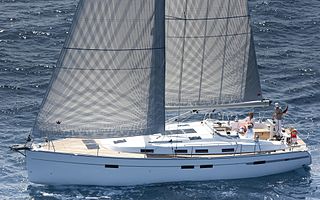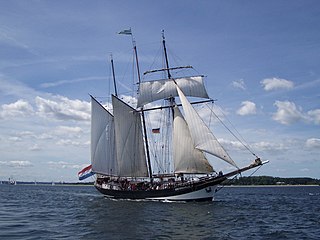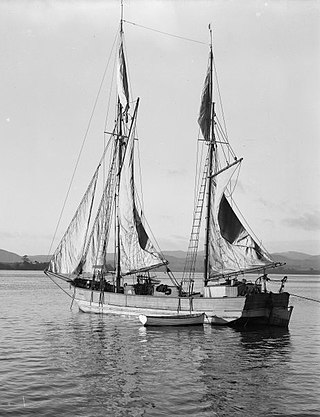
Sailing employs the wind—acting on sails, wingsails or kites—to propel a craft on the surface of the water, on ice (iceboat) or on land over a chosen course, which is often part of a larger plan of navigation.

A yacht is a sailing or power vessel used for pleasure, cruising, or racing. There is no standard definition, though the term generally applies to vessels with a cabin intended for overnight use. To be termed a yacht, as opposed to a boat, such a pleasure vessel is likely to be at least 33 feet (10 m) in length and may have been judged to have good aesthetic qualities.

A schooner is a type of sailing vessel defined by its rig: fore-and-aft rigged on all of two or more masts and, in the case of a two-masted schooner, the foremast generally being shorter than the mainmast. A common variant, the topsail schooner also has a square topsail on the foremast, to which may be added a topgallant. Differing definitions leave uncertain whether the addition of a fore course would make such a vessel a brigantine. Many schooners are gaff-rigged, but other examples include Bermuda rig and the staysail schooner.

A sailing ship is a sea-going vessel that uses sails mounted on masts to harness the power of wind and propel the vessel. There is a variety of sail plans that propel sailing ships, employing square-rigged or fore-and-aft sails. Some ships carry square sails on each mast—the brig and full-rigged ship, said to be "ship-rigged" when there are three or more masts. Others carry only fore-and-aft sails on each mast, for instance some schooners. Still others employ a combination of square and fore-and-aft sails, including the barque, barquentine, and brigantine.

A dinghy is a type of small boat, often carried or towed by a larger vessel for use as a tender. Utility dinghies are usually rowboats or have an outboard motor. Some are rigged for sailing but they differ from sailing dinghies, which are designed first and foremost for sailing. A dinghy's main use is for transfers from larger boats, especially when the larger boat cannot dock at a suitably-sized port or marina.

A scow is a smaller type of barge. Some scows are rigged as sailing scows. In the 19th and early 20th centuries, scows carried cargo in coastal waters and inland waterways, having an advantage for navigating shallow water or small harbours. Scows were in common use in the American Great Lakes and other parts of the U.S., Canada, southern England, and New Zealand. In modern times their main purpose is for recreation and racing.

A cutter is a type of watercraft. The term has several meanings. It can apply to the rig of a sailing vessel, to a governmental enforcement agency vessel, to a type of ship's boat which can be used under sail or oars, or, historically, to a type of fast-sailing vessel introduced in the 18th century, some of which were used as small warships.
This glossary of nautical terms is an alphabetical listing of terms and expressions connected with ships, shipping, seamanship and navigation on water. Some remain current, while many date from the 17th to 19th centuries. The word nautical derives from the Latin nauticus, from Greek nautikos, from nautēs: "sailor", from naus: "ship".

M5 is a sloop-rigged super yacht launched in 2003 as Mirabella V. She is the largest single-masted yacht ever built.

The word Drascombe is a trademark that was first registered by John Watkinson who applied it to a series of sailing boats which he designed and built in the period 1965–79 and sold in the United Kingdom (UK). They comprised the Coaster, Cruiser Longboat, Dabber, Drifter, Driver, Gig, Launch, Longboat, Lugger, Peterboat, Scaffie, Scaith and Skiff, together with a few other one-offs. They have wide and deep cockpits, adaptable boomless rigs and high bulwarks.

Sea Scouting has existed in Ireland since 1912 and is a programme framework within Scouting Ireland.

A fishing vessel is a boat or ship used to catch fish in the sea, or on a lake or river. Many different kinds of vessels are used in commercial, artisanal and recreational fishing.

A sailing yacht, is a leisure craft that uses sails as its primary means of propulsion. A yacht may be a sail or power vessel used for pleasure, cruising, or racing. There is no standard definition, so the term applies here to sailing vessels that have a cabin with amenities that accommodate overnight use. To be termed a "yacht", as opposed to a "boat", such a vessel is likely to be at least 33 feet (10 m) in length and have been judged to have good aesthetic qualities. Sailboats that do not accommodate overnight use or are smaller than 30 feet (9.1 m) are not universally called yachts. Sailing yachts in excess of 130 feet (40 m) are generally considered to be superyachts.
Sea Scouting has existed in Scouting Ireland and its predecessor associations since 1912. Sea Scout Groups are members of the World Organization of the Scout Movement (WOSM) through their membership of Scouting Ireland. Sea Scouting provides Scout training with and through water-borne activities.

Traditionally, many different kinds of boats have been used as fishing boats to catch fish in the sea, or on a lake or river. Even today, many traditional fishing boats are still in use. According to the United Nations Food and Agriculture Organization (FAO), at the end of 2004, the world fishing fleet consisted of about 4 million vessels, of which 2.7 million were undecked (open) boats. While nearly all decked vessels were mechanised, only one-third of the undecked fishing boats were powered, usually with outboard engines. The remaining 1.8 million boats were traditional craft of various types, operated by sail and oars.
The Juniorvlet is a steel sailing and rowing boat. It is used by the Sea Scouts of Scouting Nederland in the Netherlands. It is a smaller version of the Lelievlet craft, special designed for ages 8 to 13 years. Like a Lelievlet it can be used for Sculling, rowing and sailing. There are around 40 juniorvlets in use.

Excelsior is an authentically restored fishing smack of the Lowestoft fishing fleet and a member of the National Historic Fleet. She was built by John Chambers of Lowestoft in 1921 and worked until 1936 before being converted into a motor coaster.</ref> In 2021 Excelsior will celebrate her 100th birthday. During her time as a motor coaster she was known as Svinør and worked mainly in Norwegian waters before returning to Lowestoft in 1972.

SB Decima is a steel Thames sailing barge constructed in Southampton in 1899 by J.G. Fay and Co, Southampton for E. J. Goldsmith of Grays, Essex. She is back under sail and resident on the River Darent in Dartford, Kent. She is a notable "Historic Ship".

Padewakang were traditional boats used by the Bugis, Mandar, and Makassar people of South Sulawesi. Padewakang were used for long distance voyages serving the south Sulawesi kingdoms.

















